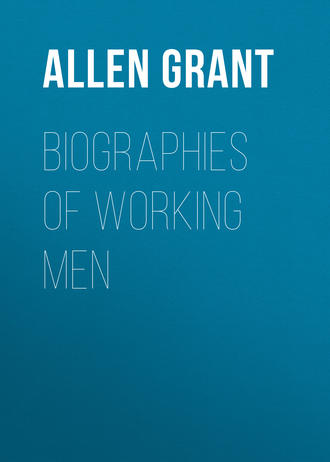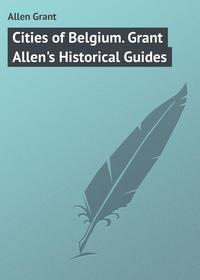 полная версия
полная версияBiographies of Working Men

Grant Allen
Biographies of Working Men
My acknowledgments are due to Dr. Smiles's "Lives of the Engineers," "Life of the Stephensons," and "Life of a Scotch Naturalist;" to Lady Eastlake's "Life of Gibson;" to Mr. Holden's "Life of Sir William Herschel;" to M. Seusier's "J. F. Millet, Sa Vie et Ses OEuvres;" and to Mr. Thayer's "Life of President Garfield;" from which most of the facts here narrated have been derived.
G. A.
I
THOMAS TELFORD, STONEMASON
High up among the heather-clad hills which form the broad dividing barrier between England and Scotland, the little river Esk brawls and bickers over its stony bed through a wild land of barren braesides and brown peat mosses, forming altogether some of the gloomiest and most forbidding scenery in the whole expanse of northern Britain. Almost the entire bulk of the counties of Dumfries, Kirkcudbright, and Ayr is composed of just such solemn desolate upland wolds, with only a few stray farms or solitary cottages sprinkled at wide distances over their bare bleak surface, and with scarcely any sign of life in any part save the little villages which cluster here and there at long intervals around some stern and simple Scottish church. Yet the hardy people who inhabit this wild and chilly moorland country may well be considered to rank among the best raw material of society in the whole of Britain; for from the peasant homes of these southern Scotch Highlands have come forth, among a host of scarcely less distinguished natives, three men, at least, who deserve to take their place in the very front line of British thinkers or workers—Thomas Telford, Robert Burns, and Thomas Carlyle. By origin, all three alike belonged in the very strictest sense to the working classes; and the story of each is full of lessons or of warnings for every one of us: but that of Telford is perhaps the most encouraging and the most remarkable of all, as showing how much may be accomplished by energy and perseverance, even under the most absolutely adverse and difficult circumstances.
Near the upper end of Eskdale, in the tiny village of Westerkirk, a young shepherd's wife gave birth to a son on the 9th of August, 1757. Her husband, John Telford, was employed in tending sheep on a neighbouring farm, and he and his Janet occupied a small cottage close by, with mud walls and rudely thatched roof, such as in southern England even the humblest agricultural labourer would scarcely consent willingly to inhabit. Before the child was three months old, his father died; and Janet Telford was left alone in the world with her unweaned baby. But in remote country districts, neighbours are often more neighbourly than in great towns; and a poor widow can manage to eke out a livelihood for herself with an occasional lift from the helping hands of friendly fellow-villagers. Janet Telford had nothing to live upon save her own ten fingers; but they were handy enough, after the sturdy Scotch fashion, and they earned some sort of livelihood in a humble way for herself and her fatherless boy. The farmers about found her work on their farms at haymaking or milking, and their wives took the child home with them while its mother was busy labouring in the harvest fields. Amid such small beginnings did the greatest of English engineers before the railway era receive his first hard lessons in the art of life.
After her husband's death, the poor widow removed from her old cottage to a still more tiny hut, which she shared with a neighbour—a very small hut, with a single door for both families; and here young Tam Telford spent most of his boyhood in the quiet honourable poverty of the uncomplaining rural poor. As soon as he was big enough to herd sheep, he was turned out upon the hillside in summer like any other ragged country laddie, and in winter he tended cows, receiving for wages only his food and money enough to cover the cost of his scanty clothing. He went to school, too; how, nobody now knows: but he did go, to the parish school of Westerkirk, and there he learnt with a will, in the winter months, though he had to spend the summer on the more profitable task of working in the fields. To a steady earnest boy like young Tam Telford, however, it makes all the difference in the world that he should have been to school, no matter how simply. Those twenty-six letters of the alphabet, once fairly learnt, are the key, after all, to all the book-learning in the whole world. Without them, the shepherd-boy might remain an ignorant, unprogressive shepherd all his life long, even his undeniable native energy using itself up on nothing better than a wattled hurdle or a thatched roof; with them, the path is open before him which led Tam Telford at last to the Menai Bridge and Westminster Abbey.
When Tam had gradually eaten his way through enough thin oatmeal porridge (with very little milk, we fear) to make him into a hearty lad of fifteen, it began to be high time for him to choose himself a final profession in life, such as he was able. And here already the born tastes of the boy began to show themselves: for he had no liking for the homely shepherd's trade; he felt a natural desire for a chisel and a hammer—the engineer was there already in the grain—and he was accordingly apprenticed to a stonemason in the little town of Lochmaben, beyond the purple hills to eastward. But his master was a hard man; he had small mercy for the raw lad; and after trying to manage with him for a few months, Tam gave it up, took the law into his own hands, and ran away. Probably the provocation was severe, for in after-life Telford always showed himself duly respectful to constituted authority; and we know that petty self-made master-workmen are often apt to be excessively severe to their own hired helpers, and especially to helpless lads or young apprentices. At any rate, Tam wouldn't go back; and in the end, a well-to-do cousin, who had risen to the proud position of steward at the great hall of the parish, succeeded in getting another mason at Langholm, the little capital of Eskdale, to take over the runaway for the remainder of the term of his indentures.
At Langholm, a Scotch country town of the quietest and sleepiest description, Tam Telford passed the next eight years of his uneventful early life, first as an apprentice, and afterwards as a journeyman mason of the humblest type. He had a good mother, and he was a good son. On Saturday nights he generally managed to walk over to the cottage at Westerkirk, and accompany the poor widow to the Sunday services at the parish kirk. As long as she lived, indeed, he never forgot her; and one of the first tasks he set himself when he was out of his indentures was to cut a neat headstone with a simple but beautiful inscription for the grave of that shepherd father whom he had practically never seen. At Langholm, an old maiden lady, Miss Pasley, interested herself kindly in Janet Telford's rising boy. She lent him what of all things the eager lad most needed—books; and the young mason applied himself to them in all his spare moments with the vigorous ardour and perseverance of healthy youth. The books he read were not merely those which bore directly or indirectly upon his own craft: if they had been, Tam Telford might have remained nothing more than a journeyman mason all the days of his life. It is a great mistake, even from the point of view of mere worldly success, for a young man to read or learn only what "pays" in his particular calling; the more he reads and learns, the more will he find that seemingly useless things "pay" in the end, and that what apparently pays least, often really pays most in the long run. This is not the only or the best reason why every man should aim at the highest possible cultivation of his own talents, be they what they may; but it is in itself a very good reason, and it is a sufficient answer for those who would deter us from study of any high kind on the ground that it "does no good." Telford found in after-life that his early acquaintance with sound English literature did do him a great deal of good: it opened and expanded his mind; it trained his intelligence; it stored his brain with images and ideas which were ever after to him a source of unmitigated delight and unalloyed pleasure. He read whenever he had nothing else to do. He read Milton with especial delight; and he also read the verses that his fellow-countryman, Rob Burns, the Ayrshire ploughman, was then just beginning to speak straight to the heart of every aspiring Scotch peasant lad. With these things Tam Telford filled the upper stories of his brain quite as much as with the trade details of his own particular useful handicraft; and the result soon showed that therein Tam Telford had not acted uncannily or unwisely.
Nor did he read only; he wrote too—verses, not very good, nor yet very bad, but well expressed, in fairly well chosen language, and with due regard to the nice laws of metre and of grammar, which is in itself a great point. Writing verse is an occupation at which only very few even among men of literary education ever really succeed; and nine-tenths of published verse is mere mediocre twaddle, quite unworthy of being put into the dignity of print. Yet Telford did well for all that in trying his hand, with but poor result, at this most difficult and dangerous of all the arts. His rhymes were worth nothing as rhymes; but they were worth a great deal as discipline and training: they helped to form the man, and that in itself is always something. Most men who have in them the power to do any great thing pass in early life through a verse-making stage. The verses never come to much; but they leave their stamp behind them; and the man is all the better in the end for having thus taught himself the restraint, the command of language, the careful choice of expressions, the exercise of deliberate pains in composition, which even bad verse-making necessarily implies. It is a common mistake of near-sighted minds to look only at the immediate results of things, without considering their remoter effects. When Tam Telford, stonemason of Langholm, began at twenty-two years of age to pen poetical epistles to Robert Burns, most of his fellow-workmen doubtless thought he was giving himself up to very foolish and nonsensical practices; but he was really helping to educate Thomas Telford, engineer of the Holyhead Road and the Caledonian Canal, for all his future usefulness and greatness.
As soon as Tam was out of his indentures, he began work as a journeyman mason at Langholm on his own account, at the not very magnificent wages of eighteenpence a day. That isn't much; but at any rate it is an independence. Besides building many houses in his own town, Tam made here his first small beginning in the matter of roads and highways, by helping to build a bridge over the Esk at Langholm. He was very proud of his part in this bridge, and to the end of his life he often referred to it as his first serious engineering work. Many of the stones still bear his private mark, hewn with the tool into their solid surface, with honest workmanship which helps to explain his later success. But the young mason was beginning to discover that Eskdale was hardly a wide enough field for his budding ambition. He could carve the most careful headstones; he could cut the most ornamental copings for doors or windows; he could even build a bridge across the roaring flooded Esk; but he wanted to see a little of the great world, and learn how men and masons went about their work in the busy centres of the world's activity. So, like a patriotic Scotchman that he was, he betook himself straight to Edinburgh, tramping it on foot, of course, for railways did not yet exist, and coaches were not for the use of such as young Thomas Telford.
He arrived in the grey old capital of Scotland in the very nick of time. The Old Town, a tangle of narrow alleys and close courtyards, surrounded by tall houses with endless tiers of floors, was just being deserted by the rich and fashionable world for the New Town, which lies beyond a broad valley on the opposite hillside, and contains numerous streets of solid and handsome stone houses, such as are hardly to be found in any other town in Britain, except perhaps Bath and Aberdeen. Edinburgh is always, indeed, an interesting place for an enthusiastic lover of building, be he architect or stonemason; for instead of being built of brick like London and so many other English centres, it is built partly of a fine hard local sandstone and partly of basaltic greenstone; and besides its old churches and palaces, many of the public buildings are particularly striking and beautiful architectural works. But just at the moment when young Telford walked wearily into Edinburgh at the end of his long tramp, there was plenty for a stout strong mason to do in the long straight stone fronts of the rising New Town. For two years, he worked away patiently at his trade in "the grey metropolis of the North;" and he took advantage of the special opportunities the place afforded him to learn drawing, and to make minute sketches in detail of Holyrood Palace, Heriot's Hospital, Roslyn Chapel, and all the other principal old buildings in which the neighbourhood of the capital is particularly rich. So anxious, indeed, was the young mason to perfect himself by the study of the very best models in his own craft, that when at the end of two years he walked back to revisit his good mother in Eskdale, he took the opportunity of making drawings of Melrose Abbey, the most exquisite and graceful building that the artistic stone-cutters of the Middle Ages have handed down to our time in all Scotland.
This visit to Eskdale was really Telford's last farewell to his old home, before setting out on a journey which was to form the turning-point in his own history, and in the history of British engineering as well. In Scotch phrase, he was going south. And after taking leave of his mother (not quite for the last time) he went south in good earnest, doing this journey on horseback; for his cousin the steward had lent him a horse to make his way southward like a gentleman. Telford turned where all enterprising young Scotchmen of his time always turned: towards the unknown world of London—that world teeming with so many possibilities of brilliant success or of miserable squalid failure. It was the year 1782, and the young man was just twenty-five. No sooner had he reached the great city than he began looking about him for suitable work. He had a letter of introduction to the architect of Somerset House, whose ornamental fronts were just then being erected, facing the Strand and the river; and Telford was able to get a place at once on the job as a hewer of the finer architectural details, for which both his taste and experience well fitted him. He spent some two years in London at this humble post as a stone-cutter; but already he began to aspire to something better. He earned first-class mason's wages now, and saved whatever he did not need for daily expenses. In this respect, the improvidence of his English fellow-workmen struck the cautious young Scotchman very greatly. They lived, he said, from week to week entirely; any time beyond a week seemed unfortunately to lie altogether outside the range of their limited comprehension.
At the end of two years in London, Telford's skill and study began to bear good fruit. His next engagement was one which raised him for the first time in his life above the rank of a mere journeyman mason. The honest workman had attracted the attention of competent judges. He obtained employment as foreman of works of some important buildings in Portsmouth Dockyard. A proud man indeed was Thomas Telford at this change of fortune, and very proudly he wrote to his old friends in Eskdale, with almost boyish delight, about the trust reposed in him by the commissioners and officers, and the pains he was taking with the task entrusted to him. For he was above all things a good workman, and like all good workmen he felt a pride and an interest in all the jobs he took in hand. His sense of responsibility and his sensitiveness, indeed, were almost too great at times for his own personal comfort. Things will go wrong now and then, even with the greatest care; well-planned undertakings will not always pay, and the best engineering does not necessarily succeed in earning a dividend; but whenever such mishaps occurred to his employers, Telford felt the disappointment much too keenly, as though he himself had been to blame for their miscalculations or over-sanguine hopes. Still, it is a good thing to put one's heart in one's work, and so much Thomas Telford certainly did.
About this time, too, the rising young mason began to feel that he must get a little more accurate scientific knowledge. The period for general study had now passed by, and the period for special trade reading had set in. This was well. A lad cannot do better than lay a good foundation of general knowledge and general literature during the period when he is engaged in forming his mind: a young man once fairly launched in life may safely confine himself for a time to the studies that bear directly upon his own special chosen subject. The thing that Telford began closely to investigate was—lime. Now, lime makes mortar; and without lime, accordingly, you can have no mason. But to know anything really about lime, Telford found he must read some chemistry; and to know anything really about chemistry he must work at it hard and unremittingly. A strict attention to one's own business, understood in this very broad and liberal manner, is certainly no bad thing for any struggling handicraftsman, whatever his trade or profession may happen to be.
In 1786, when Telford was nearly thirty, a piece of unexpected good luck fell to his lot. And yet it was not so much good luck as due recognition of his sterling qualities by a wealthy and appreciative person. Long before, while he was still in Eskdale, one Mr. Pulteney, a man of social importance, who had a large house in the bleak northern valley, had asked his advice about the repairs of his own mansion. We may be sure that Telford did his work on that occasion carefully and well; for now, when Mr. Pulteney wished to restore the ruins of Shrewsbury Castle as a dwelling-house, he sought out the young mason who had attended to his Scotch property, and asked him to superintend the proposed alterations in his Shropshire castle. Nor was that all: by Mr. Pulteney's influence, Telford was shortly afterwards appointed to be county surveyor of public works, having under his care all the roads, bridges, gaols, and public buildings in the whole of Shropshire. Thus the Eskdale shepherd-boy rose at last from the rank of a working mason, and attained the well-earned dignity of an engineer and a professional man.
Telford had now a fair opportunity of showing the real stuff of which he was made. Those, of course, were the days when railroads had not yet been dreamt of; when even roads were few and bad; when communications generally were still in a very disorderly and unorganized condition. It is Telford's special glory that he reformed and altered this whole state of things; he reduced the roads of half Britain to system and order; he made the finest highways and bridges then ever constructed; and by his magnificent engineering works, especially his aqueducts, he paved the way unconsciously but surely for the future railways. If it had not been for such great undertakings as Telford's Holyhead Road, which familiarized men's minds with costly engineering operations, it is probable that projectors would long have stood aghast at the alarming expense of a nearly level iron road running through tall hills and over broad rivers the whole way from London to Manchester.
At first, Telford's work as county surveyor lay mostly in very small things indeed—mere repairs of sidepaths or bridges, which gave him little opportunity to develop his full talents as a born engineer. But in time, being found faithful in small things, his employers, the county magistrates, began to consult him more and more on matters of comparative importance. First, it was a bridge to be built across the Severn; then a church to be planned at Shrewsbury, and next, a second church in Coalbrookdale. If he was thus to be made suddenly into an architect, Telford thought, almost without being consulted in the matter, he must certainly set out to study architecture. So, with characteristic vigour, he went to work to visit London, Worcester, Gloucester, Bath, and Oxford, at each place taking care to learn whatever was to be learned in the practice of his new art. Fortunately, however, for Telford and for England, it was not architecture in the strict sense that he was finally to practise as a real profession. Another accident, as thoughtless people might call it, led him to adopt engineering in the end as the path in life he elected to follow. In 1793, he was appointed engineer to the projected Ellesmere Canal.
In the days before railways, such a canal as this was an engineering work of the very first importance. It was to connect the Mersey, the Dee, and the Severn, and it passed over ground which rendered necessary some immense aqueducts on a scale never before attempted by British engineers. Even in our own time, every traveller by the Great Western line between Chester and Shrewsbury must have observed on his right two magnificent ranges as high arches, which are as noticeable now as ever for their boldness, their magnitude, and their exquisite construction. The first of these mighty archways is the Pont Cysylltau aqueduct which carries the Ellesmere Canal across the wide valley of the Dee, known as the Vale of Llangollen; the second is the Chirk aqueduct, which takes it over the lesser glen of a minor tributary, the Ceriog. Both these beautiful works were designed and carried out entirely by Telford. They differ from many other great modern engineering achievements in the fact that, instead of spoiling the lovely mountain scenery into whose midst they have been thrown, they actually harmonize with it and heighten its natural beauty. Both works, however, are splendid feats, regarded merely as efforts of practical skill; and the larger one is particularly memorable for the peculiarity that the trough for the water and the elegant parapet at the side are both entirely composed of iron. Nowadays, of course, there would be nothing remarkable in the use of such a material for such a purpose; but Telford was the first engineer to see the value of iron in this respect, and the Pont Cysylltau aqueduct was one of the earliest works in which he applied the new material to these unwonted uses. Such a step is all the more remarkable, because Telford's own education had lain entirely in what may fairly be called the "stone age" of English engineering; while his natural predilections as a stonemason might certainly have made him rather overlook the value of the novel material. But Telford was a man who could rise superior to such little accidents of habit or training; and as a matter of fact there is no other engineer to whom the rise of the present "iron age" in engineering work is more directly and immediately to be attributed than to himself.
Meanwhile, the Eskdale pioneer did not forget his mother. For years he had constantly written to her, in print hand, so that the letters might be more easily read by her aged eyes; he had sent her money in full proportion to his means; and he had taken every possible care to let her declining years be as comfortable as his altered circumstances could readily make them. And now, in the midst of this great and responsible work, he found time to "run down" to Eskdale (very different "running down" from that which we ourselves can do by the London and North Western Railway), to see his aged mother once more before she died. What a meeting that must have been, between the poor old widow of the Eskdale shepherd, and her successful son, the county surveyor of Shropshire, and engineer of the great and important Ellesmere Canal!
While Telford was working busily upon his wonderful canal, he had many other schemes to carry out of hardly less importance, in connection with his appointment as county surveyor. His beautiful iron bridge across the Severn at Build was was another application of his favourite metal to the needs of the new world that was gradually growing up in industrial England; and so satisfied was he with the result of his experiment (for though not absolutely the first, it was one of the first iron bridges ever built) that he proposed another magnificent idea, which unfortunately was never carried into execution. Old London Bridge had begun to get a trifle shaky; and instead of rebuilding it, Telford wished to span the whole river by a single iron arch, whose splendid dimensions would have formed one of the most remarkable engineering triumphs ever invented. The scheme, for some good reason, doubtless, was not adopted; but it is impossible to look at Telford's grand drawing of the proposed bridge—a single bold arch, curving across the Thames from side to side, with the dome of St Paul's rising majestically above it—without a feeling of regret that such a noble piece of theoretical architecture was never realized in actual fact.











